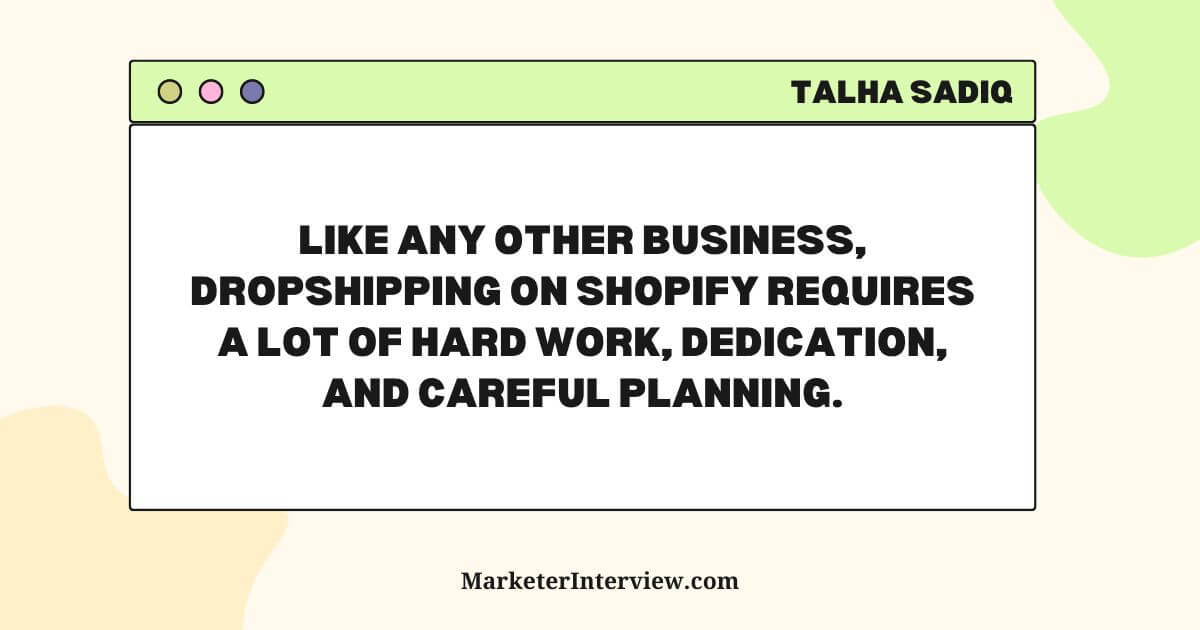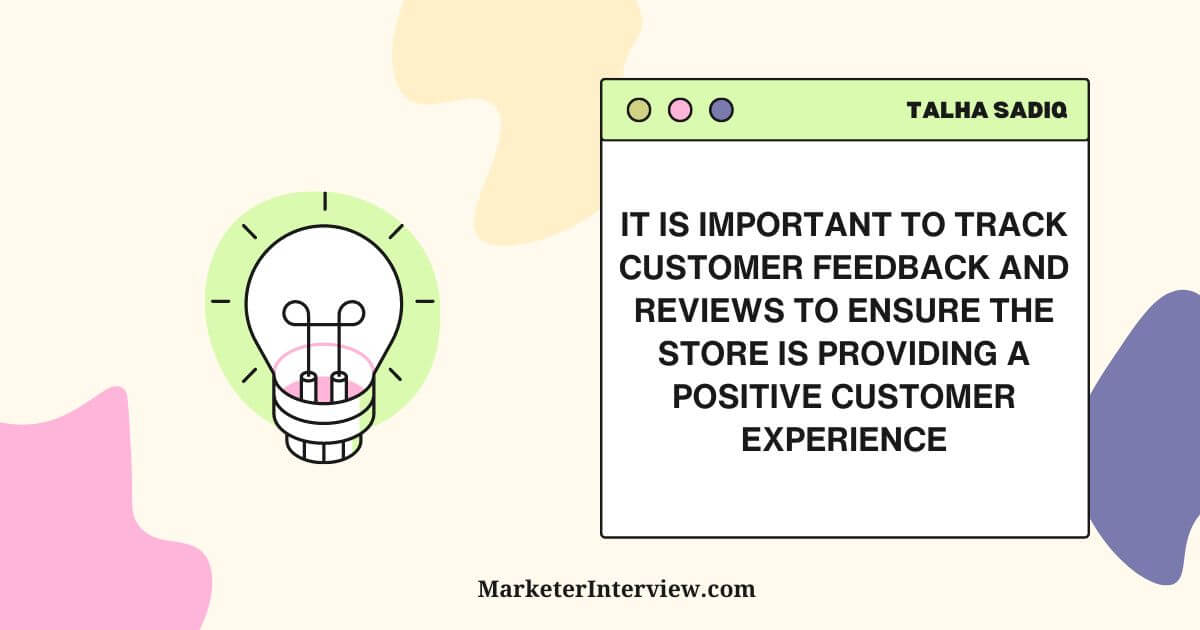Interview with Talha Sadiq: Insights and Tips for a Profitable Dropshipping Store on Shopify
In this interview, Talha Sadiq, a successful dropshipper on Shopify, shares insights and tips on how to run a profitable dropshipping store on Shopify.
Talha discusses the common misconceptions about dropshipping on Shopify, the key components of a successful dropshipping store, how to find and select profitable niches and products, and the challenges and mistakes to avoid. He also talks about the importance of customer reviews and feedback, and how to encourage customers to leave reviews.
Finally, Talha shares advice for beginners and recommends some resources to learn more about dropshipping on Shopify.
Contents
- 1 Can you tell us a little bit about your background and how you got into dropshipping on Shopify?
- 2 What are some common misconceptions people have about dropshipping on Shopify, and how would you address them?
- 3 What are the essential steps to take when starting a dropshipping business on Shopify?
- 4 How do you go about selecting a profitable niche for a dropshipping store on Shopify? What factors do you consider?
- 5 Can you walk us through the process of finding and selecting the right products to sell on a dropshipping store on Shopify?
- 6 What are some effective ways to drive traffic to a dropshipping store on Shopify? How do you evaluate the success of these efforts?
- 7 What are some common mistakes people make when setting up a dropshipping store on Shopify? How can they avoid them?
- 8 What are some of the challenges you’ve encountered while setting up and running a dropshipping store on Shopify? How have you overcome them?
- 9 What role do customer reviews and feedback play in the success of a dropshipping store on Shopify? How do you encourage customers to leave reviews?
- 10 Finally, what advice do you have for someone who is just starting out with dropshipping on Shopify? What resources would you recommend they use to learn more?
Can you tell us a little bit about your background and how you got into dropshipping on Shopify?
Sure! I come from a business background and have always been interested in entrepreneurship. I first learned about dropshipping while researching different business models and was immediately drawn to its low-risk nature.
I found Shopify to be the most user-friendly platform for setting up a dropshipping store, and so I decided to give it a try. It took some time and effort to learn the ropes and figure out effective marketing strategies, but with persistence, I was able to build a successful dropshipping business on Shopify.
What are some common misconceptions people have about dropshipping on Shopify, and how would you address them?
One common misconception about dropshipping on Shopify is that it’s a quick and easy way to make money without much effort. This is simply not true. Like any other business, dropshipping on Shopify requires a lot of hard work, dedication, and careful planning.
Another misconception is that anyone can succeed in dropshipping, regardless of their level of experience or knowledge. In reality, dropshipping requires a good understanding of the business model, the products being sold, and the market demand.
Finally, some people believe that dropshipping on Shopify is not a legitimate business, but this is a myth. Dropshipping is a legitimate business model that has proven successful for many entrepreneurs.

What are the essential steps to take when starting a dropshipping business on Shopify?
The essential steps to take when starting a dropshipping business on Shopify include:
Conducting market research to identify profitable products and niches
- Selecting a reliable supplier
- Setting up a Shopify account
- Creating a well-designed website
- Optimizing the website for search engines.
It is also important to develop a detailed business plan and marketing strategy, as well as establish a strong brand identity.
How do you go about selecting a profitable niche for a dropshipping store on Shopify? What factors do you consider?
Researching and evaluating potential suppliers is crucial for the success of a dropshipping store on Shopify. One of the best ways to find suppliers is to search online marketplaces such as Alibaba or Oberlo.
When evaluating potential suppliers, consider their reputation, experience, and reviews from other customers. Look for suppliers with a good track record of delivering products on time and offering high-quality items. Consider the cost of the products, shipping times, and their return policies, as these will affect customer satisfaction and the profitability of the store.
Finally, it is a good idea to communicate with potential suppliers to ensure that they are responsive and able to meet your needs. A supplier who can offer consistent quality and reliability can be a valuable partner for a successful dropshipping store on Shopify.
Can you walk us through the process of finding and selecting the right products to sell on a dropshipping store on Shopify?
As for the process of finding and selecting the right products to sell, one approach is to use product research tools like Google Trends or Jungle Scout to identify popular and trending products.
It is also helpful to analyze data from competitors’ stores to see what products are selling well in the market. Another approach is to consider products that have a high profit margin and low competition.
Remember to select products that fit within the chosen niche and cater to the target audience’s needs and preferences. Once a list of potential products has been identified, it is important to research the suppliers to ensure that they can provide quality products consistently and have a reliable shipping process.
What are some effective ways to drive traffic to a dropshipping store on Shopify? How do you evaluate the success of these efforts?
There are several effective ways to drive traffic to a dropshipping store on Shopify, including leveraging social media platforms, email marketing campaigns, search engine optimization (SEO), and pay-per-click (PPC) advertising.
Social media platforms like Facebook, Instagram, and Pinterest can be used to build brand awareness, engage with potential customers, and drive traffic to the store. Email marketing campaigns can be used to target specific segments of customers and provide them with personalized product recommendations and promotions.
SEO involves optimizing the website for search engines so that it ranks higher in search results. This can be done by using relevant keywords, optimizing page titles and descriptions, and building quality backlinks. Finally, PPC advertising involves placing targeted ads on search engines or social media platforms to drive traffic to the store.
To evaluate the success of these efforts, track website analytics, such as website traffic, bounce rates, and conversion rates. This will provide insight into how customers are interacting with the store and where improvements can be made.
Additionally, it is important to track customer feedback and reviews to ensure the store is providing a positive customer experience. By monitoring the success of these efforts, dropshipping store owners can optimize their marketing strategies and drive more traffic to their store.

What are some common mistakes people make when setting up a dropshipping store on Shopify? How can they avoid them?
One common mistake people make when setting up a dropshipping store on Shopify is rushing to launch without doing enough research on the products they are selling. To avoid this, take the time to research and evaluate potential products, suppliers, and competitors before launching the store.
Another mistake is not having a good understanding of the dropshipping business model. It is important to understand the logistics of dropshipping, including shipping times, inventory management, and customer service. Having a detailed marketing plan is also crucial for success. Consider investing in SEO, social media advertising, and email marketing to reach potential customers.
In addition, ensure that the store is well-designed, with clear and attractive product descriptions, and that the products available are of good quality. Finally, it is important to ensure there is good customer service and that the store is being properly managed.
Consider outsourcing tasks such as order fulfillment and customer service to ensure the store runs smoothly. By taking the time to research, plan, and properly manage the store, you can avoid these common mistakes and increase the chances of success for your dropshipping business on Shopify.
What are some of the challenges you’ve encountered while setting up and running a dropshipping store on Shopify? How have you overcome them?
The main challenges I have encountered while setting up and running a dropshipping store on Shopify have been related to understanding the platform, managing marketing efforts, and sourcing products.
To overcome these challenges, I have used online resources to learn more about the platform and marketing strategies, and I have reached out to suppliers to ensure I am getting the best products at the best prices. Additionally, I have used tracking and analytics to ensure the store is running efficiently and successfully.
What role do customer reviews and feedback play in the success of a dropshipping store on Shopify? How do you encourage customers to leave reviews?
Customer reviews and feedback are essential to the success of a dropshipping store on Shopify, as they provide insight into the customer experience and can help identify areas of improvement.
To encourage customers to leave reviews, it is important to provide good customer service and a positive shopping experience. Additionally, it is important to send follow-up emails to customers asking for their feedback, and to offer incentives for leaving reviews.
Finally, what advice do you have for someone who is just starting out with dropshipping on Shopify? What resources would you recommend they use to learn more?
My advice: Take your time and do research. It is important to understand the business model, the different products available, and the different strategies for marketing and customer service.
It is important to identify a niche that is not saturated with competition and to ensure the products available are of good quality. I’d recommend that someone starting out with dropshipping on Shopify use online resources such as Shopify’s blog and tutorials, as well as other blogs and forums related to dropshipping.
Moreover, there are many online courses and e-books available for those looking to learn more about dropshipping. Stay up-to-date on the latest developments in the industry to ensure the store is running efficiently and successfully.






